
All about the water pump (pump) of the cooling system
Content
Any internal combustion engine is subjected to critical thermal stress during operation. So that overheating of the unit does not cause its imminent failure, it needs cooling. The most common cooling system scheme includes a pump that pumps coolant through the line.
Consider the device of the mechanism, what is the water pump, on what principle it will work, what are the malfunctions and how to fix them yourself.
What is a water pump?
The pump is installed as close as possible to the engine block. One part of the mechanism will necessarily be in the block itself, since its impeller must, when rotating, bring the fluid in the system into action. A little later, we will consider different modifications of these devices. If you take a classic car water pump, it can be found at the bottom of the engine.
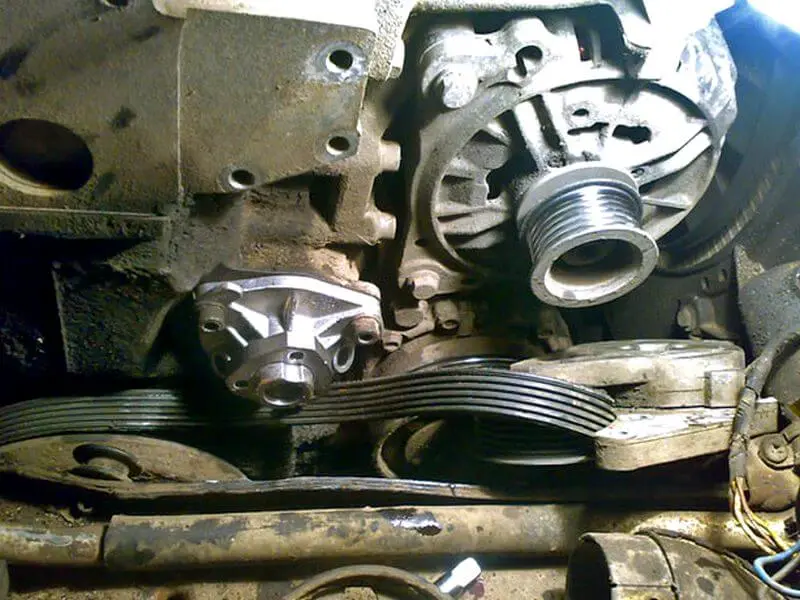
For it to work, the design of the mechanism implies the presence of a pulley, which is connected to the power unit through a belt drive. In this version, the hydraulic pump will operate while the power unit is running. If the pump fails, this will affect the operation of the car motor (due to overheating, it will fail).
appointment
So, the pump in the car is part of the cooling of the power unit. Details about how the system is arranged, and what its principle of operation is, is described in another review... But in short, there are two varieties of them. The first provides cooling of the unit with the help of air flow, therefore it will be called air.
The second type of system is liquid. It is filled with a special liquid - antifreeze or antifreeze (about how this substance differs from water, read here). But in order for the motor to cool during operation, it is necessary to ensure the circulation of this liquid. Otherwise, the engine block will be hot, and the substance in the radiator will be cold.
As the name of the mechanism implies, its purpose is to pump the working fluid (antifreeze or antifreeze) in the line connected to the motor. Forced circulation accelerates the supply of cooled liquid from the radiator to the engine (so that the cooling process takes place with maximum efficiency, the engine has a water jacket - special channels made in the cylinder block housing). The antifreeze itself is cooled by natural (when the car is moving) or forced airflow (this function is performed by a fan, about which read in detail separately) radiator.
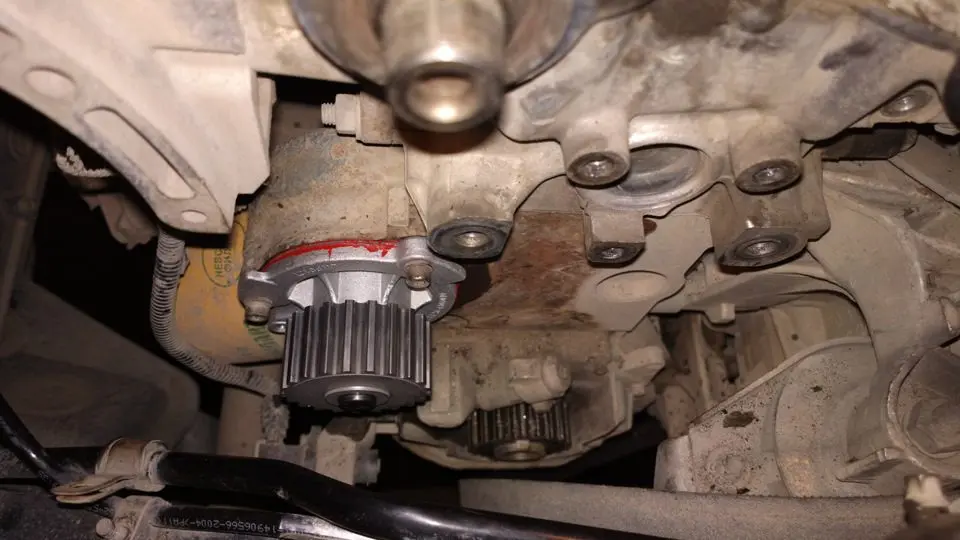
In addition to cooling the engine, thanks to the pump, the heating in the cabin also works. This system operates on the same principle of heat exchange between the radiator fins and the ambient air, only in this case the heat is not removed from the car, but is used to create a comfortable temperature in the car interior. When air passes through the heating element, it will also cool the circuit to some extent (if air is taken from outside the car), so sometimes owners of old cars recommend turning on the interior heating when the car is in a traffic jam so that the engine does not boil. For more information on how heating works in a car, read here.
Centrifugal pump device
The classic car water pump has a fairly simple device. This modification will consist of a minimum number of parts, due to which the mechanism has a long service life. Its design includes:
- The body (the material from which it is made must withstand high loads and constant vibrations - mainly cast iron or aluminum);
- The shaft on which all the actuators are installed;
- A bearing that prevents the shaft from rubbing against the device body and ensures uniform rotation of the impeller;
- Impeller (made of plastic or metal), providing pumping of the working medium into the circuits;
- An oil seal providing a seal at the place of installation of bearings and shaft;
- Seal of pipes (heat-resistant rubber);
- Retaining ring;
- Pressure spring (found in models that are installed on older motors).
The photo below shows a section of one of the most common modifications of automobile water pumps:
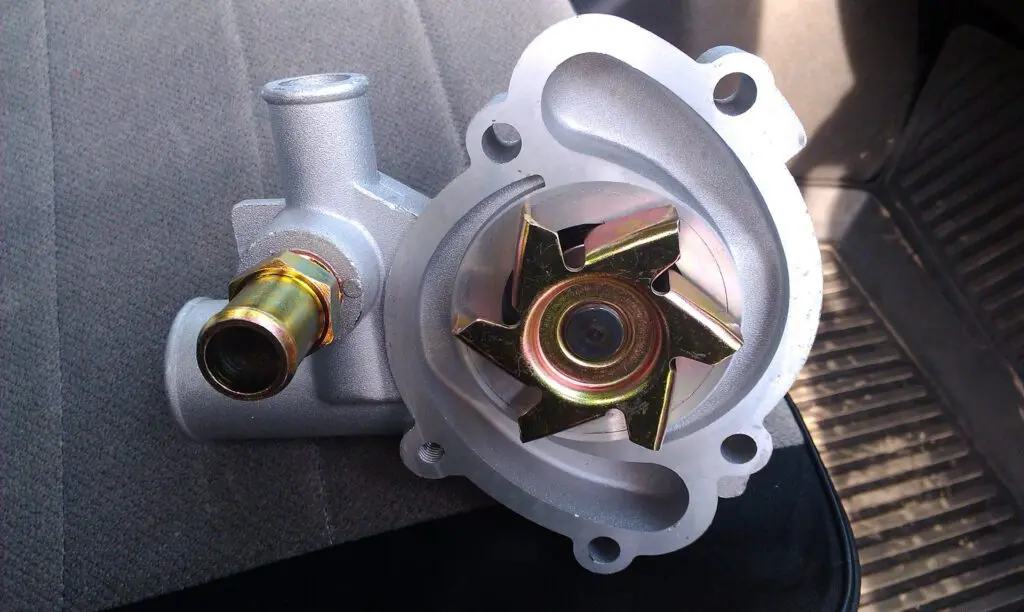
A pulley is mounted on the shaft (in many modifications it is toothed). This element allows you to connect the pump drive to the gas distribution mechanism, which in turn works by rotating the crankshaft. All these mechanisms are synchronized with each other and form a single system that uses one drive. The torque is transmitted either by the timing belt (read about it in detail here), or the corresponding chain, which is described in another article.
Due to the fact that the pump has a constant coupling with the crankshaft, it provides pressure in the line due to the crankshaft speed. With an increase in engine speed, the pump begins to work more intensively.
To prevent the hydraulic pump from suffering from constant vibrations of the internal combustion engine, a gasket is installed between the engine block and the pump housing at the installation site, which dampens the vibrations. In the place where the blades are located, the body is slightly widened, and there are three branches in it. The first is connected to the branch pipe from the radiator, to the second - the branch pipe of the cooling jacket, and to the third - the heater.
How the pump works
The work of the water pump is as follows. When the driver starts the engine, torque is transferred from the crankshaft pulley through a belt or chain to the pump pulley. Due to this, the shaft rotates, on which the impeller is mounted on the side opposite to the pulley.
The pump has a centrifugal principle of operation. The circulation mechanism is capable of creating a pressure of up to one atmosphere, which ensures that liquid is pumped into all circuits, depending on which unit is opened by the thermostat valve. For details on why a thermostat is needed in the cooling system, read separately... Also, the pressure in the cooling system is necessary in order to increase the antifreeze boiling threshold (this indicator is directly proportional to the pressure in the line - the higher it is, the higher the temperature the internal combustion engine will boil).
Each pump blade is tilted. Due to this, the impeller provides a fast movement of the working medium in the housing. From the inside, the pump casing has such a device that, due to the centrifugal force, the antifreeze is directed to the outlets connected to the corresponding circuits. Due to the difference in pressure in the supply and return, antifreeze begins to move inside the line.
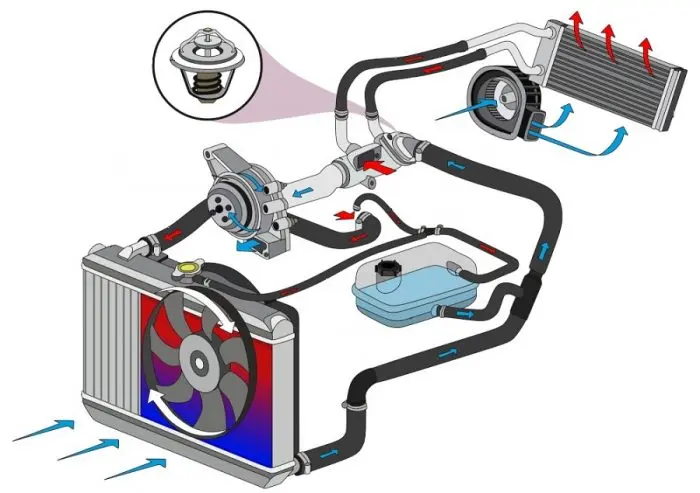
The action of the pump ensures the movement of the coolant in the line according to the following scheme:
- From the impeller, due to the strong rotation (centrifugal force) of the blades, the antifreeze is thrown out to the wall of the housing, which smoothly passes to the outlet. This is how injection into the circuit occurs.
- From this outlet, the liquid enters the jacket of the internal combustion engine. It is designed in such a way that the coolant first passes by the hottest parts of the unit (valves, cylinders).
- Then the antifreeze goes through the thermostat. If the motor is in the warm-up phase, the circuit closes and the working fluid enters the pump inlet (the so-called small circulation circle). In a warm engine, the thermostat is open, so the antifreeze goes to the radiator. By blowing off the heat exchanger, the coolant temperature is reduced.
- At the inlet to the pump, the pressure of the working medium is lower than at the outlet, which is why a vacuum is created in this part of the line, and fluid is sucked from the more loaded part of the OS. Thanks to this, the antifreeze passes through the radiator tubes and enters the pump inlet.
Systems with an additional pump
Some modern vehicles use cooling systems that have an additional water blower installed. In such a scheme, one pump still remains the main one. The second, depending on the design of the system and the design of the engine, can perform the following action:
- Provide additional cooling to the power unit. This is especially important if the machine is operated in hot regions.
- Increase the centrifugal force for the auxiliary heater circuit (it can be connected to the vehicle's cooling line).
- If the car is equipped with an exhaust gas recirculation system (what it is, it is described separately), then the additional pump is designed to better cool the exhaust gases.
- If a turbocharged engine is installed under the hood of the car, then the auxiliary supercharger will provide cooling of the compressor, since it is heated by the effect of exhaust gases on the drive impeller of the device.
- In some systems, after stopping the engine, the coolant continues to circulate through the line thanks to the operation of the additional supercharger, so that after an intense drive the engine does not overheat. This happens because the main hydraulic pump stops working after the power unit is deactivated.
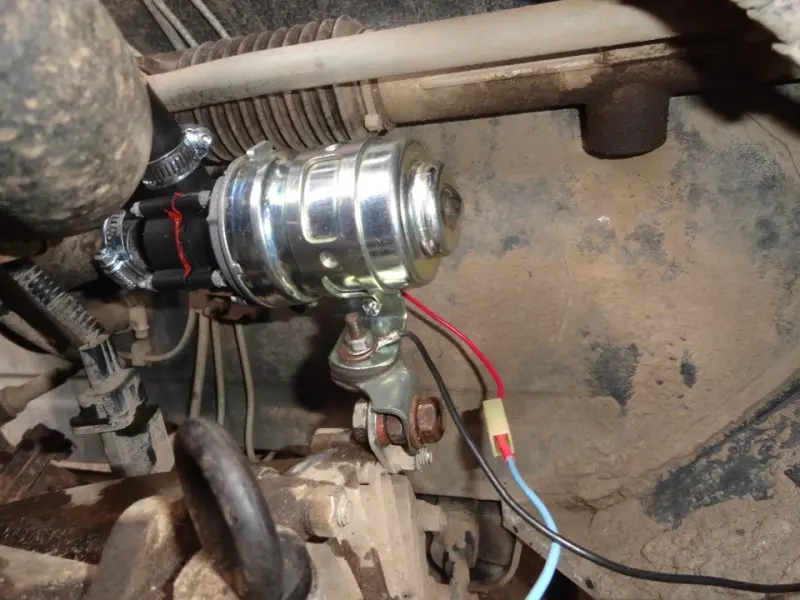
Basically, these auxiliary liquid blowers are electrically driven. This electric pump is controlled by an ECU.
Shut-off pump
Another type of cooling system is equipped with a switchable pump. The main task of just such a modification is to speed up the process of warming up the power unit. Such a pump works according to the same principle as the classic analogue. The only difference is that its design has a special valve that blocks the outlet of antifreeze from the pump to the cooling jacket of the motor.
Most motorists know that all liquid-cooled internal combustion engines cool down to ambient temperature after long periods of inactivity. In order for the unit to work efficiently, after starting it must reach the operating temperature (about what this value should be, read here). But, as we have already seen, the cooling system starts working as soon as the ICE starts up. To make the unit warm up faster, the engineers equipped it with two cooling circuits (small and large). But modern developments make it possible to further accelerate the process of warming up the engine.
In order for the combustion of the air-fuel mixture to take place with maximum efficiency, it must be heated to a certain degree. In this case, gasoline evaporates (a diesel engine works according to a different principle, but it also needs a temperature regime so that the compressed air corresponds to the self-ignition temperature of diesel fuel), due to which it burns better.
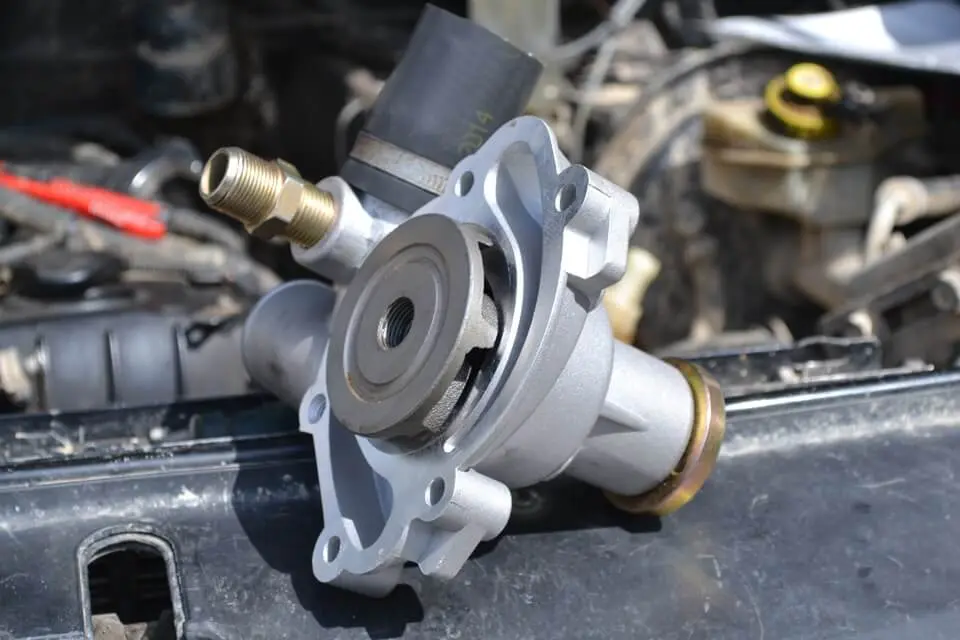
In operating systems that have a switchable pump mechanism, the supercharger also continues to work, only for heating the motor, the outlet is blocked by a damper. Thanks to this, the antifreeze does not move in the cooling jacket, and the block heats up much faster. Such a mechanism is also controlled by an ECU. When the microprocessor detects a stable coolant temperature in the block in the region of 30 degrees, the electronics opens the damper using the vacuum line and the corresponding levers, and circulation begins in the system. The rest of the system works identically to the classic one. Such a pump device provides a decrease in the load on the internal combustion engine during its warming up. Such systems have proven themselves in regions with low ambient temperatures, even in summer.
Types and design of water pumps
Despite the fact that water car pumps do not have cardinal differences in design, they are conventionally divided into two categories:
- Mechanical pump. This is a classic modification that is used in most car models. The design of such a pump was described above. It works by transmitting torque through a belt connected to the crankshaft pulley. The mechanical pump operates synchronously with the internal combustion engine.
- Electric pump. This modification also provides constant coolant circulation, only its drive is different. An electric motor is used to rotate the impeller shaft. It is controlled by the ECU microprocessor in accordance with the algorithms that are flashed at the factory. The electric pump has its advantages. Among them is the ability to turn off circulation for accelerated warm-up of the internal combustion engine.
Also, pumps are classified according to the following criteria:
- Main pump. The purpose of this mechanism is one - to provide coolant pumping in the system.
- Additional supercharger. Such pump mechanisms are installed only on some cars. Depending on the type of internal combustion engine and the circuit of the cooling system, these devices are used for additional cooling of the engine, turbine, exhaust gas recirculation system and circulating antifreeze after stopping the engine. The secondary element differs from the main pump in its drive - its shaft is driven into rotation by an electric motor.
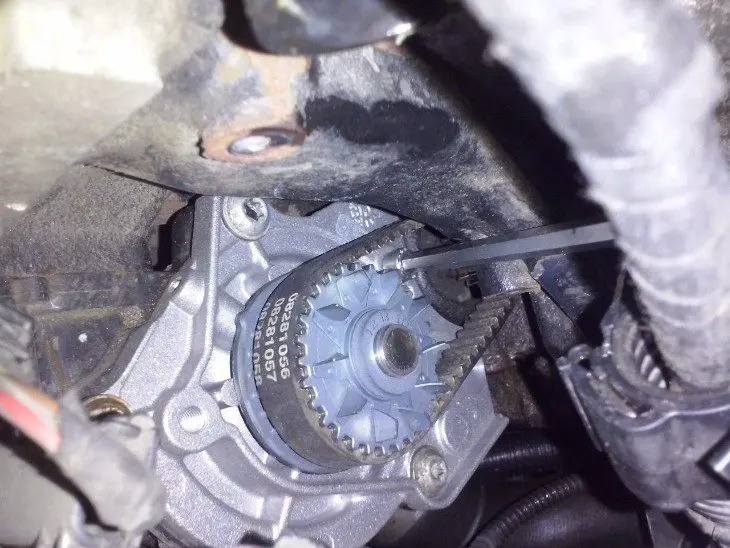
Another way to classify water pumps is by design type:
- Unbreakable. In this version, the pump is considered a consumable that must be replaced during routine maintenance (although it is not changed as often as oil) of the car. Such modifications have a simple design, making replacement of the mechanism much cheaper compared to more expensive collapsible counterparts that can be repaired. This procedure should always be accompanied by the installation of a new timing belt, the breakage of which in some cars is fraught with serious damage to the power unit.
- Collapsible pump. These modifications were used in older machines. This modification allows you to perform some repairs to the mechanism, as well as its maintenance (wash, lubricate or replace the failed parts).
Common coolant pump malfunctions
If the pump fails, the engine cooling stops working. Such a malfunction will certainly lead to overheating of the internal combustion engine, but this is in the best outcome. The worst is when a breakdown of the water blower leads to a break in the timing belt. Here are the most common hydraulic pump breakdowns:
- The gland has lost its properties. Its task is to prevent the ingress of antifreeze into the bearing race. In such a case, the bearing grease is flushed out by the coolant. Although the chemical composition of the coolant is oily and much softer than normal water, this substance still adversely affects the performance of the bearings. When this element loses its lubrication, over time it will definitely give a wedge.
- The impeller has broken. In this case, depending on the degree of damage to the blades, the system will work for some time, but a fallen off blade can block the course of the working environment, so this damage cannot be ignored either.
- Shaft play has appeared. Since the mechanism is constantly rotating at high speed, the place of the backlash will gradually break. Subsequently, the system will start to work unstable, or even break down altogether.
- Rust on internal pump parts. This happens when a motorist pours a low-quality coolant into the system. When a leak occurs in the OS, the very first thing many motorists do is fill in ordinary water (distilled at best). Since this liquid does not have a lubricating effect, the metal parts of the pump corrode over time. This fault also leads to a wedge of the drive mechanism.
- Cavitation. This is the effect when air bubbles burst with such force, which leads to the destruction of the elements of the device. Because of this, the weakest and most affected parts are destroyed during the operation of the device.
- Extraneous elements have appeared in the system. The appearance of dirt is due to untimely maintenance of the system. Also, if the motorist neglects the recommendations for using antifreeze, not water. In addition to rust due to high temperatures in the line, scale will certainly appear. At best, it will just slightly hinder the free movement of the coolant, and in the worst case, these deposits can break off and damage the working mechanisms, for example, prevent the thermostat valve from moving.
- Bearing failure. This is due to natural wear or due to the leakage of antifreeze from the system through the oil seal. Such a malfunction can be eliminated only by replacing the pump.
- Timing belt broke. This failure can only be attributed to the pump in the case of the device drive wedge. In any case, the lack of torque on the drive will not allow the motor to function (valve timing and ignition will not work in accordance with the cylinder strokes).
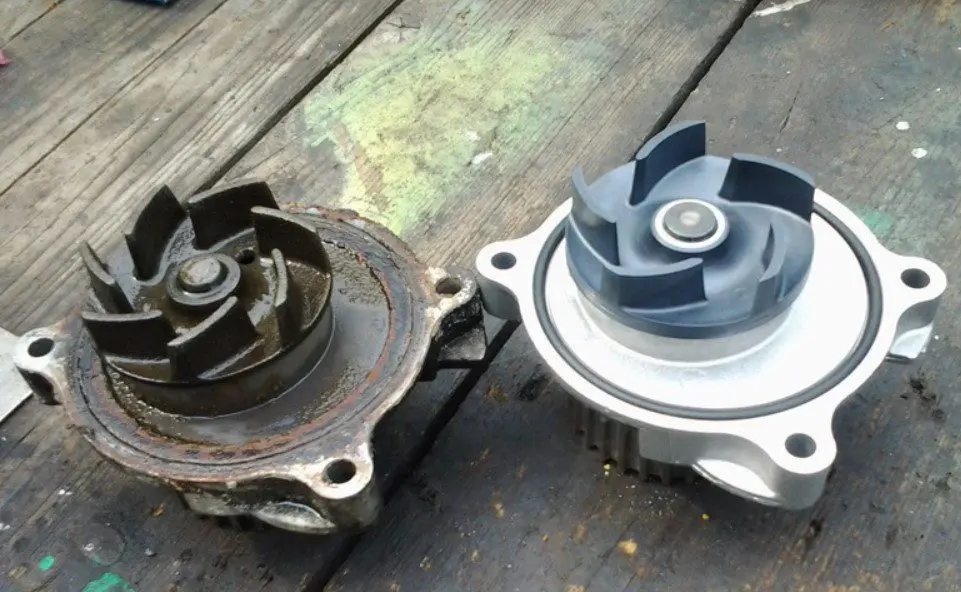
For the motor to overheat, it is enough to stop the pump for just a few minutes. Critical temperatures in combination with a large mechanical load can lead to deformation of the cylinder head, as well as to breakage of parts of the KShM. In order not to spend decent funds on engine overhauls, it is much cheaper to carry out routine maintenance of the cooling system and replace the pump.
Symptoms of a malfunction
The very first sign of CO malfunctions is a rapid and critical increase in the temperature of the motor. In this case, the antifreeze in the expansion tank may be cool. First of all, you need to check the thermostat - it may just be in the closed position due to failure. So that the driver can independently determine the malfunctions in the cooling system, an internal combustion engine temperature sensor is installed on the dashboard.
The next symptom indicating the need for repair work is the leakage of antifreeze in the pump area. In this case, the coolant level in the expansion tank will fall (the rate of this depends on the degree of damage). You can add antifreeze to the system when the engine cools down a little (due to the large temperature difference, the block may crack). Although you can continue driving with minor leaks of antifreeze, it is better to go to the service station as early as possible to prevent more serious damage. In this case, it is necessary to minimize the load on the internal combustion engine.
Here are some other signs that you can recognize a hydraulic pump malfunction:
- During the start of an unheated engine, a hum is heard from under the hood, but before changing the pump, it is necessary to additionally check the condition of the generator (it also works from the timing belt, and in some breakdowns it emits an identical sound). How to check the generator, there is another review.
- Antifreeze leak appeared from the pump drive side. It can be caused by shaft play, wear of the seal, or leakage of the stuffing box.
- Visual inspection of the mechanism showed the presence of shaft play, but no coolant leak. In case of such malfunctions, the pump changes to a new one, but if the model is disassembled, then the bearing and the oil seal must be replaced.
Causes of malfunction of the water pump
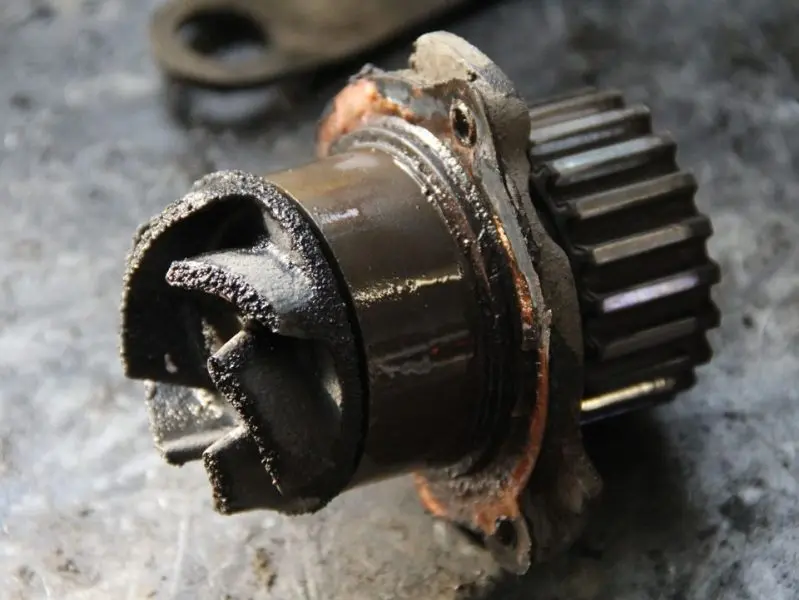
Malfunctions of the pump of the engine cooling system are caused by three factors:
- Firstly, like all mechanisms in a car, this device tends to wear out. For this reason, car manufacturers establish certain regulations for the replacement of different types of devices. Bearing or impeller may break.
- Secondly, the motorist himself can accelerate the breakdown of the mechanism. For example, it will break down faster if not antifreeze is poured into the system, but water, even if distilled. A harsher environment can lead to scale formation. Deposits can flake off and block fluid flow. Also, improper installation of the mechanism can render it unusable, for example, excessive tension on the belt will certainly lead to bearing failure.
- Thirdly, the leakage of antifreeze through the oil seal will sooner or later provoke a bearing failure.
DIY pump repair
If a collapsible pump is installed on the motor, if it breaks down, it can be repaired. Although the work can be done independently, it is better to entrust it to a professional. The reason for this is the specific clearances between the device body and the shaft. The professional will also be able to determine if the device can be repaired or not.
Here is the sequence in which such a pump is being repaired:
- The drive belt is dismantled (it is important to make marks on the timing pulleys and crankshaft so that the valve timing does not shift);
- The fastening bolts are unscrewed;
- The entire pump is removed from the engine;
- Disassembly is carried out by dismantling the retaining rings;
- The drive shaft is pressed out;
- After pressing out the shaft, the bearing in most cases remains in the housing, so it is also pressed out;
- At this stage, worn-out elements are thrown away and new ones are installed instead;
- The mechanism is assembled and installed on the internal combustion engine.
The subtleties of this procedure depend on the type of motor and the design of the pump itself. For this reason, repairs must be carried out by a professional who understands such subtleties.
Replacement
Most modern power units are equipped with a non-separable pump. If it breaks down, the mechanism changes to a new one. For most cars, the procedure is almost identical. The pulley itself does not need to be dismantled, as it is part of the design of the hydraulic pump.
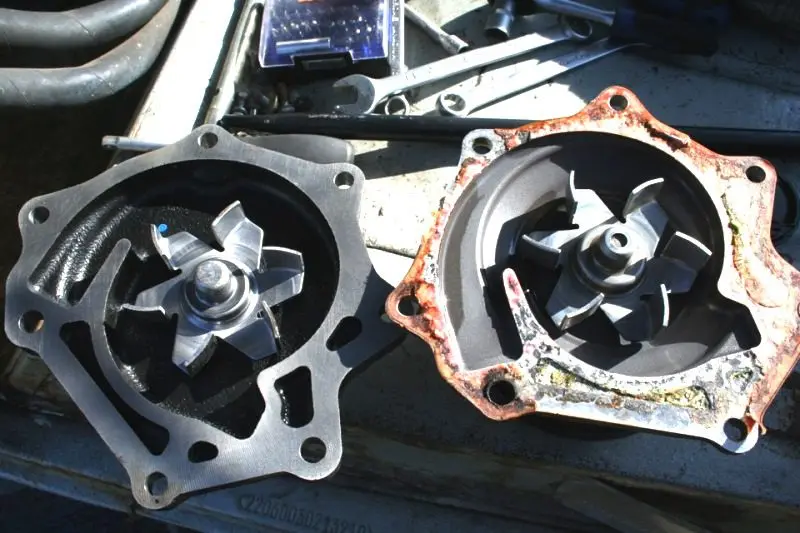
The replacement procedure is performed in the following sequence:
- The drive belt is removed, but before that marks are placed on the timing and crankshaft;
- The fastening bolts are unscrewed and the pump is dismantled;
- Install the new hydraulic pump in reverse order.
Regardless of whether the pump is being repaired or replaced, before starting work, it is necessary to drain the antifreeze from the system. And here's another subtlety. Most new pumps are sold without gum, so you need to purchase it separately. It is also worth considering that access to the pump is not free in all car models, and requires a good knowledge of how the engine compartment is organized in a particular case.
If the pump is not replaced in time, then, at best, the antifreeze will slowly leave the system (it leaks through the oil seal). Such a malfunction does not require large expenditures, since a small leak by many motorists is "eliminated" by adding antifreeze.
If the leakage of antifreeze is serious, but the driver did not notice it in time, then the engine will certainly overheat (poor circulation or its absence due to a low coolant level). Driving with such a malfunction will sooner or later lead to breakdowns of the power unit itself. Their degree depends on the condition of the engine parts. The worst thing is changing the geometry of the cylinder head.
Due to frequent overheating of the motor, microcracks will appear in the block, which will subsequently lead to a complete replacement of the internal combustion engine. Deformation of the head can lead to the fact that the circuits of the cooling and lubrication systems can shift, and antifreeze will enter the motor, which is also fraught with the unit.
Malfunction prevention
So, given the critical consequences of the failure of an automobile hydraulic pump, every car owner must carry out timely preventive work. This list is small. The most important thing is to adhere to the automaker's recommendations for planned replacement:
- Antifreeze. Moreover, the quality of this substance needs to be given a lot of attention;
- Water pump;
- Timing belt (complete set with idler and idler rollers, the number of which depends on the motor model).
An important factor is the proper level of coolant in the reservoir. This parameter is easy to control thanks to the corresponding markings on the tank. If possible, it is better to exclude the ingress of foreign substances into the OS line (for example, when a leak appears in the radiator, some motorists pour special substances into the tank that create a dense layer inside the circuit). A clean engine cooling system will not only prevent pump damage, but also provide high-quality engine cooling.
At the end of the review, we suggest watching a short video about the engine pump:
Questions and answers:
How to identify a pump malfunction? Noises coming from the motor while it is running. Pump pulley play, coolant leaks. Rapid motor temperature rise and frequent overheating.
What are pumps for? This is an element of the cooling system. The pump, or water pump, provides constant circulation of antifreeze through the system, accelerating heat transfer between the motor and the environment.
How does a water pump work in a car? In the classic version, it is connected to the crankshaft through a belt. While the crankshaft rotates, the pump impeller also rotates. There are models with an individual electric drive.
One comment
Andrew
I knew there was coolant circulating in the engine cooling system, NOT water in any case. So the pump can only be antifreeze, NOT water. What professionals you are!